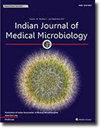多粘菌素和多粘菌素B与美罗培南、利福平和替加环素协同作用的变化:印度耐碳青霉烯鲍曼不动杆菌的体外研究
IF 1.4
4区 医学
Q4 IMMUNOLOGY
引用次数: 0
摘要
目的在资源有限的情况下,耐碳青霉烯鲍曼不动杆菌感染的有效治疗选择有限。未来与多粘菌素联合使用的抗菌药物需要进行协同试验,以减轻耐药性的进一步发展。本研究评估了粘菌素和多粘菌素B联合美罗培南、利福平和替加环素对血液感染的CRAB分离株的协同作用。方法选取流行病学上有明显差异的25株CRAB菌株。采用肉汤微量稀释法测定了抗菌药物的最低抑菌浓度(mic)。采用棋盘肉汤微量稀释法(CBM)评价各抗菌组合的增效作用。抗微生物药物的浓度为预期MIC的4 ~ 8倍至1/8 ~ 1/16,最终接种量为105 CFU/mL。使用时间杀伤试验(TKA)证实了显示出更大协同活性的抗菌组合。结果所有菌株均对多粘菌素耐药(MIC≤4 mg/L)。在CBM试验中,粘菌素-美罗培南、粘菌素-利福平和粘菌素-替加环素联合使用比多粘菌素-美罗培南、多粘菌素-利福平和多粘菌素-替加环素联合使用具有更好的协同作用(P=<0.001, P= 0.03和P= 0.01)。在TKA中,粘菌素(0.1 ~ 0.5 mg/L)与亚抑制浓度的美罗培南(4 ~ 8 mg/L)、利福平(1 ~ 4 mg/L)和替加环素(0.06 ~ 0.25 mg/L)联合使用对部分菌株在24 h时表现出增效和杀菌活性。我们的研究结果表明,亚抑制浓度的抗菌药物组合可以提高治疗效果,并尽量减少多粘菌素的副作用。此外,体内研究是必要的,以优化联合治疗。本文章由计算机程序翻译,如有差异,请以英文原文为准。

Varied synergistic activity of colistin and polymyxin B with meropenem, rifampicin and tigecycline: An in vitro study on carbapenem resistant Acinetobacter baumannii from India
Purpose
Effective therapeutic choices for infections by carbapenem resistant Acinetobacter baumannii (CRAB) in resource constrained settings is limited. Prospective antimicrobial combinations with polymyxins, need to be tested for synergy to mitigate further development of resistance. This study evaluates the synergistic effects of colistin and polymyxin B combined with meropenem, rifampicin, and tigecycline against CRAB isolates from bloodstream infections.
Methods
Twenty-five epidemiologically distinct CRAB strains were included. The minimum inhibitory concentrations (MICs) of the antimicrobials were determined by broth microdilution. The synergistic activities of the antimicrobial combinations were evaluated by checkerboard broth microdilution (CBM). Antimicrobials were tested at concentrations from 4 to 8 times down to 1/8–1/16 of their expected MIC, with a final inoculum of 105 CFU/mL. The antimicrobial combinations that demonstrated greater synergistic activity were confirmed using the time-kill assay (TKA).
Results
None of the strains were resistant to polymyxins (MIC ≤4 mg/L). Colistin-meropenem, colistin-rifampicin and colistin-tigecycline combinations achieved superior synergy over the polymyxin B-meropenem, polymyxin B-rifampicin and polymyxin B-tigecycline combinations (P=<0.001, P = 0.03, and P = 0.01, respectively) in the CBM assay. In the TKA, combinations of colistin (0.1–0.5 mg/L) with subinhibitory concentrations of meropenem (4–8 mg/L), rifampicin (1–4 mg/L), and tigecycline (0.06–0.25 mg/L) exhibited synergistic and bactericidal activity against a subset of isolates at 24 h.
Conclusions
Significant concordance between the CBM and TKA was observed. Our findings suggest that subinhibitory antimicrobial concentrations in combinations can improve therapeutic efficacy and minimize polymyxin side effects. Additionally, in vivo studies are warranted to optimize the combinational therapy.
求助全文
通过发布文献求助,成功后即可免费获取论文全文。
去求助
来源期刊

Indian Journal of Medical Microbiology
IMMUNOLOGY-
CiteScore
2.20
自引率
0.00%
发文量
154
审稿时长
73 days
期刊介绍:
Manuscripts of high standard in the form of original research, multicentric studies, meta analysis, are accepted. Current reports can be submitted as brief communications. Case reports must include review of current literature, clinical details, outcome and follow up. Letters to the editor must be a comment on or pertain to a manuscript already published in the IJMM or in relation to preliminary communication of a larger study.
Review articles, Special Articles or Guest Editorials are accepted on invitation.
 求助内容:
求助内容: 应助结果提醒方式:
应助结果提醒方式:


